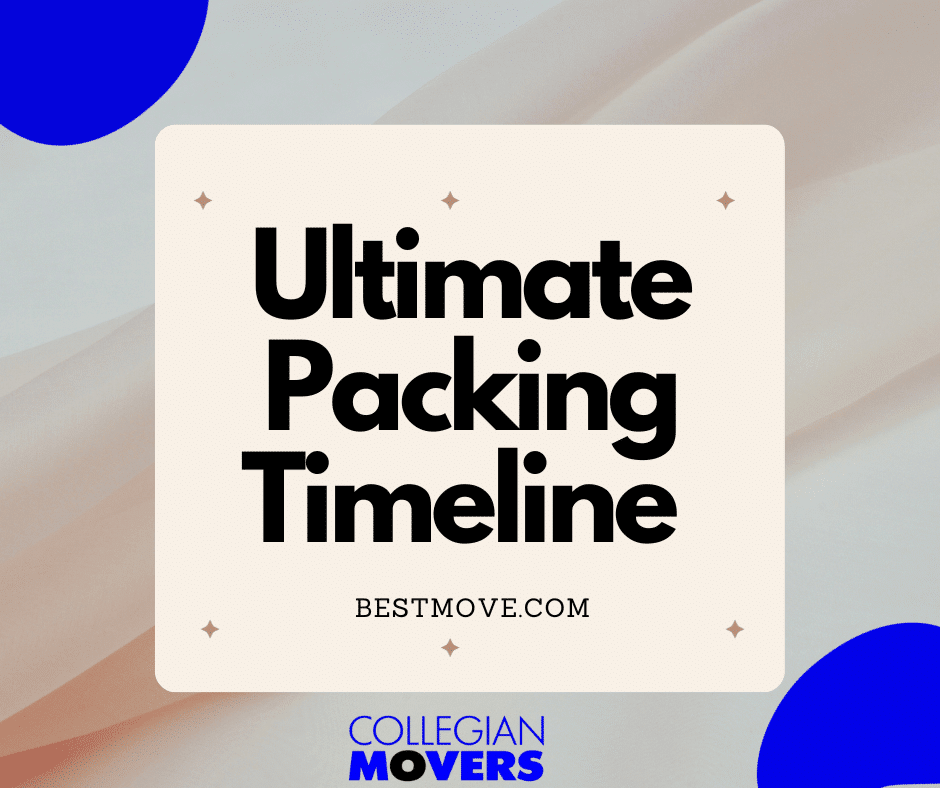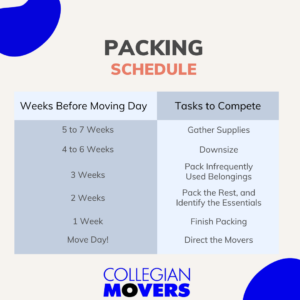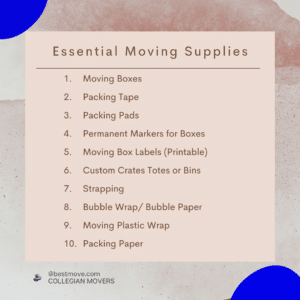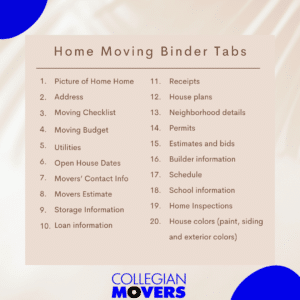Moving Preparation Schedule: Your Guide to Packing Timelines

"*" indicates required fields


The Ultimate Packing Timeline for a Smooth Move
Packing Timeline: Moving can be a daunting task, especially if it’s your first time. That’s why the Collegian Movers Blog is here to help! Our relocation blog is a valuable resource for anyone planning a business or residential move. We understand that moving requires thorough research and knowledge, which is why we offer a wealth of information on various topics, including moving, relocation, and best practices.
To help movers navigate the moving process successfully, we have included in our blog, a wide range of resources, including helpful information on packing, packing tips, checklists, how-to’s and moving advice. We cover topics ranging from pre-move preparations to a packing schedule for moving during the move, and even post-move organization. Our goal is to provide you with the expertise you need to make your move as smooth and stress-free as possible.
When to Begin Packing: The Early Bird Gets the Worm
When moving a packing timeline is a crucial aspect of starting the moving process, and the question that often lingers is, “When should I start packing?” The answer is simple: as early as possible. However, packing isn’t just about putting your belongings into boxes; it’s a journey that involves meticulous planning, organization, and a touch of excitement. In this comprehensive guide, we’ll provide you with a detailed packing timeline and essential tips to make your move a smooth and stress-free experience.
Step 1: Create a 5-Step Packing Timeline For a Stress Free Move
Packing Timeline For A Move – Keep a Schedule
5 TO 7 WEEKS BEFORE MOVING DAY: GATHER SUPPLIES
- Get new boxes or containers/bins.
- Buy packing tape and dispensers.
- Use medium-tipped permanent markers for labeling.
- Get packing paper or padding material.
- If not using movers, buy or rent necessary moving equipment (dollies, straps, blankets).
4 TO 6 WEEKS BEFORE MOVING DAY: DOWNSIZE
- Declutter and sell items you no longer need.
- Donate or give away unsold items.
- Dispose of hazardous materials properly.
- Throw out remaining unwanted items and remove them from the home.
3 WEEKS BEFORE MOVING DAY: PACK INFREQUENTLY USED BELONGINGS
- Pack seasonal or rarely used items.
- Pack tools or other items you won’t need before the move. [Leave out basics for disassembly of furniture.]
- Stack boxes in the rooms where you packed them.
2 WEEKS BEFORE MOVING DAY: PACK THE REST, AND IDENTIFY ESSENTIALS
- Start packing kitchenware. [Leave essential items aside.]
- Identify “Open Me First” items.
- Identify items to travel with you instead of the movers. [Medications, valuable documents, jewelry]
1 WEEK BEFORE MOVING DAY: FINISH PACKING
- Pack and label the remaining “Open Me First” items.
- Check and ensure all boxes are properly sealed and labeled.
Step 2: Begin to Declutter As Soon As the Move Is Confirmed
As soon as contracts have been exchanged and you have your move-in date, it’s a great time to start decluttering your home. Begin by removing anything you don’t want or need. Think about the new location, if you do not have a planned space for it get rid of it.
Step 3: Take Measurements of Your New Home (As Long as It’s Possible)
Measure your new home to ensure your existing furniture fits. If some items don’t fit, consider ordering new ones before moving day. Make plans for the furniture that does not fit. Perhaps donate or sell it, or rent a storage unit to keep it until you can use it. Consider using some online websites or apps to help with the measurements. They are quite handy and can do the job for you quickly. Use the mobile measurement apps to create floor plans and calculate square footage effortlessly.
Step 4: Organize and Schedule Movers
Two months out from the move is a reasonable time to book professional movers. If you plan to move yourself, consider how you will move your vehicle in addition to the rental truck.
Step 5: Start Packing Non-Essential Items
Begin packing non-essential items such as books, special occasion tableware, photographs, seasonal clothing, and holiday decorations. Remove decorative household items if you’re comfortable with them.
Step 6: Request Time Off and Plan How to Use Up Opened Items
Request time off from work to deal with the move. It is difficult to determine exactly how long a move will take or if something goes wrong, so it is best to free up your move day. Plan to use up opened items such as toiletries and food to avoid spills during the move.
Step 7: Order Any Essential Moving Supplies
Ensure you have the essential packing supplies like tape, boxes, labels, markers, and bubble wrap. Consider using clear bins for regularly used items for easy access.
Step 8: Start Packing More of Your Items
Three to four weeks before moving is the ideal time to begin packing the majority of your household items. Start with less important items and progress to your daily essentials as the move approaches.
Step 9: Label Boxes According to Your New Home
Ensure boxes are labeled accurately, indicating the room where the items are going in the new home, minimizing confusion.
Step 10: Move Items into Storage If Necessary
If needed, move items into storage to create more space and decide which items will move with you.
Step 11: Pack Kitchen Items You Don’t Use Regularly
Pack infrequently used kitchen items two weeks before the move, leaving behind only essential cooking equipment.
Step 12: Make a List of People to Notify of Your Move
Compile a list of people and organizations to notify about your move, including your workplace, bank, and any household service providers. Notify all relevant parties of your change of address, including workplaces, banks, and service providers.
Step 13: Investigate Home Insurance
Organize home insurance to ensure coverage for your new home from day one.
Step 14: Pack Important Items You Want to Keep an Eye On
Pack precious items separately to ensure their safety and easy access during the move.
Step 15: Box Up Those Remaining Items
The final week before your move is the time to pack away the rest of your household items.
To break this down, this means boxing up almost all of your kitchen items, aside from the basics that you’ll need to prepare meals – such as saucepans, a range of utensils, a few glasses and mugs, and some cutlery.
This is also the time to focus on your wardrobe, So, pack everything except for a few outfits. Pack the majority of your wardrobe, keeping in mind the season and weather conditions at your destination.
Additionally, start to pack your bathroom. Pack most of your toiletries, leaving out only the essentials for personal hygiene in the days leading up to the move, such as toothpaste, shampoos, and soap.
Step 16: Put Together a Moving Binder
Keep your packing timeline and all essential documents in a moving binder, including insurance papers, contracts, and receipts. You’ll want to decide which tabs are useful for you. You might decide to establish these on the fly as you receive papers related to your move or create tabs ahead of time to ensure you don’t misplace anything related to your new home.
Step 17: Put Together a Bag of Essentials
Pack a suitcase with essential items for the first night and morning in your new home to avoid rummaging through boxes.
Step 18: Clean Your New Home
Before leaving, clean your former home to ensure it’s in good condition for the new tenants or owners. Per most real estate contracts, it needs to a minimum be “broom swept” clean.
Conclusion: Your Stress-Free Move Awaits
This comprehensive packing timeline and checklist will help make your move a smooth and stress-free experience. Remember, flexibility is key, and adjustments may be necessary based on your unique circumstances. Happy moving!
REQUEST A FREE MOVING QUOTE NOW
Or Call: 800-966-6838
Can’t talk right now? Fill out our FREE online form to receive your moving company quote via email.
Reviews from Our Valued Clients
There is no greater satisfaction for us than being able to assist our clients in achieving their objectives. We feel deeply appreciative for the opportunity to serve them.
Very Pleased with My Movers
I was pleased with the professionalism and courtesy shown by Collegian Movers. The moving team was friendly very helpful and considerate of my move. (Mary C.)
Great Moving Company!
These guys were very detail-oriented and were always more than happy to answer all of my questions. (Adam M.)
Seamless Residential Move
My residential moving experience went off without a hitch. (Michelle B.)
Multiple Moves
Collegian Movers NEVER disappoint! (Karen C.)
The Move Went Very, Very Well
The movers were polite and very willing to help in any way we needed. (Kevin S.)
Moving with Collegian Movers was a Breeze!
The movers themselves arrived on time and were quick, courteous, and professional. (Alice T.)
Happy Customer
I was happy with the service and professionalism of everyone. (Dave L.)
GOAT!
This company is fantastic- love the drivers, loaders, and packers!!!! (Cindy B.)
Smooth Moving Experience
The experience with Collegian Movers’ customer service & professionalism was exceptional. The team was highly professional, friendly, and considerate, ensuring a smooth & stress-free move. I am extremely pleased with the service provided by Collegian Movers. (Steve R.)
Highly Satisfied With My Move
Exceptional experience with Collegian Movers! Matt and George were easy to do business with, they prioritized my move, addressing concerns and going above and beyond. They consistently exceeded expectations, ensuring a seamless and stress-free experience. Highly satisfied! (Tom Z.)
Move Surpassed My Expectations
My overall experience with Collegian Movers was exceptional. The team’s professionalism and courtesy ensured a smooth, issue-free process. George’s excellent communication made coordination effortless, and the hardworking crew handled everything with care. Collegian Movers excelled in every aspect, earning my trust for future moves. They surpassed my expectations and deserve the highest recommendation for their outstanding work! (Bruce N.)
Top-Notch Movers
Collegian Movers was top-notch-super efficient and professional. From the sales team’s quick guidance to the friendly movers’ punctual arrival, they made the whole move a breeze. The crew was detail-oriented and adapted smoothly to my changing needs. They were dedicated to preventing any damage and impressed with their professionalism. (Carl K.)
Punctual Movers
The entire team, from move-out to arrival, was courteous and efficient, making the experience stress-free. Collegian Movers consistently exceeded expectations, delivering on promises with punctuality and a friendly attitude. In a nutshell, they were impeccable in terms of efficiency and professionalism. Highly recommend! (Sarah G.)
Exceptional Movers
Our out-of-state move with Collegian Movers was exceptional! From the first call to furniture delivery, everything was smooth and damage-free. The movers were professional, courteous, and efficient-both during the initial move-out and the arrival at our new location. (Stan L.)
Impressive Overall Moving Team
Warner, the cross-country driver, made us aware of our inventory’s condition and quantity, going over it before departure and upon arrival. The coordination by the office, particularly from Matt, provided excellent communication and support, addressing any questions or concerns.George’s initial quote impressed us with its speed and accuracy in inventorying our furniture. Though there was a slight difference in estimated and actual weight, we were promptly informed about the cost, with no hidden fees. Transparent pricing added to our overall satisfaction. (Lucy K.)
Impressive Movers
Collegian Movers’ out-of-state service was delightful. The team’s professionalism, efficiency, attention to detail, and excellent communication left a great impression. We’d gladly use their services again in the future. (Marc T.)
Meticulous Workers
Had a great experience with Collegian Movers! Their attention to detail and responsiveness to my questions were top-notch. The team was professional, courteous, and thorough in every aspect of my move. They left no stone unturned to ensure it went smoothly. Highly recommend Collegian Movers for their meticulous work and excellent customer support! (Larry H.)
Organized and Great Communication
Collegian Movers nailed it with communication and organization! The sales team responded quickly, offering excellent guidance. Erin in the office was consistently pleasant and always available for my questions. She even checked in on move day, going above and beyond. Their top-notch communication and organization made the whole experience seamless and efficient! (Alexandra M.)
Amazing Experience with Collegian Movers!
Overall satisfaction was exceptional. From the get-go, the sales team gave prompt and friendly guidance for a smooth process. The truck arrived on time, and the movers were not only friendly but also considerate of my changing needs. No hitches at all, greatly contributing to my overall satisfaction!










